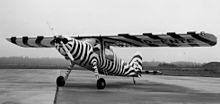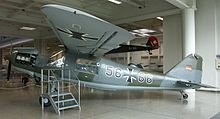
The Dornier Do 17 is a twin-engined light bomber produced by Dornier Flugzeugwerke for the German Luftwaffe during World War II. Designed in the early 1930s as a Schnellbomber intended to be fast enough to outrun opposing aircraft, the lightly built craft had a twin tail and "shoulder wing". Sometimes referred to as the Fliegender Bleistift, it was popular among its crews due to its handling, especially at low altitude, which made the Do 17 harder to hit than other German bombers.
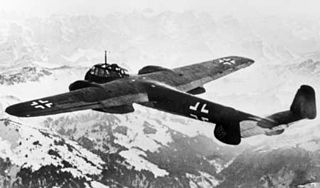
The Dornier Do 215 was a light bomber, aerial reconnaissance aircraft and later a night fighter, produced by Dornier originally for export, but in the event most served in the Luftwaffe. Like its predecessor, the Dornier Do 17, it inherited the title "The Flying Pencil" because of its slim fuselage. The successor of the Do 215 was the Do 217.

The Dornier Do 335Pfeil ("Arrow") is a heavy fighter built by Dornier for Germany during World War II. The Pfeil's performance was predicted to be better than other twin-engine designs due to its unique push-pull configuration and the lower aerodynamic drag of the in-line alignment of the two engines. It was Nazi Germany's fastest piston-engined aircraft of World War II. The Luftwaffe was desperate to get the design into operational use, but delays in engine deliveries meant that only a handful were delivered before the war ended.

The Dornier Do 11 was a German heavy bomber, developed in secret in the early 1930s. It was originally called the Dornier F before being renamed by the Reichsluftfahrtministerium (RLM) in 1933, and was considered a heavy bomber at the time. It came into service in 1932, a continuation of a line of bomber designs from the Dornier Do P in 1930, and the Dornier Do Y in 1931. The line would continue to develop with the Dornier Do 13 and Dornier Do 23.

The Dornier Do 12 Libelle III was the third of a line of small German flying boats of the 1930s. It started with the Dornier A Libelle I and the Dornier A Libelle II, though the Do 12 was not a continuation, but an entirely new aircraft.

The Dornier Do J Wal ("whale") is a twin-engine German flying boat of the 1920s designed by Dornier Flugzeugwerke. The Do J was designated the Do 16 by the Reich Air Ministry (RLM) under its aircraft designation system of 1933.

The Dornier Do 23 was a German medium bomber of the 1930s.

The Dornier Do 24 is a 1930s German three-engine flying boat designed by the Dornier Flugzeugwerke for maritime patrol and search and rescue. A total of 279 were built among several factories from 1937 to 1945.

The Fairchild F-27 and Fairchild Hiller FH-227 were versions of the Fokker F27 Friendship twin-engined, turboprop, passenger aircraft manufactured under license by Fairchild Hiller in the United States. The Fairchild F-27 was similar to the standard Fokker F27, while the FH-227 was an independently developed, stretched version.
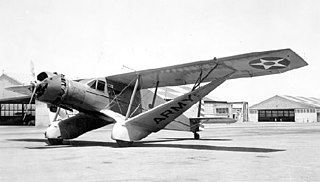
The Bellanca Aircruiser and Airbus were high-wing, single-engine aircraft built by Bellanca Aircraft Corporation of New Castle, Delaware. The aircraft was built as a "workhorse" intended for use as a passenger or cargo aircraft. It was available with wheels, floats or skis. The aircraft was powered by either a Wright Cyclone or Pratt and Whitney Hornet engine. The Airbus and Aircruiser served as both commercial and military transports.

The Cessna 310 is an American four-to-six-seat, low-wing, twin-engine monoplane produced by Cessna between 1954 and 1980. It was the first twin-engine aircraft that Cessna put into production following its first twin, the Cessna T-50 manufactured for World War II.

The Dornier Do 31 is an experimental, jet-propelled, vertical take-off and landing (VTOL) cargo aircraft that was designed and produced by West German aircraft manufacturer Dornier.

The Dornier Do 22 was a German seaplane, developed in the 1930s. Despite good performance, it was built only in small numbers and entirely for the export market. The type was operated in the Second World War by Finland, Greece and Yugoslavia.

The Junkers W 34 was a German-built, single-engine, passenger and transport aircraft. Developed in the 1920s, it was taken into service in 1926. The passenger version could take a pilot and five passengers.

The Hispano HA-200 Saeta was a twin-seat jet advanced trainer designed and produced by Spanish aircraft manufacturer Hispano Aviación. It has the distinction of being the first Spanish aircraft to harness jet propulsion.

The type designation Dornier Do 28 comprises two different twin-engine STOL utility aircraft, manufactured by Dornier Flugzeugbau GmbH. Most of them served with the German Air Force and Marineflieger and other air forces around the world in the communications and utility role. The Do 28 series consists of the fundamentally different Do 28 A/B (1959) and Do 28 D Skyservant (1966).

The Dornier Libelle, also designated Do A, was a German open-cockpit, all-metal, parasol wing, monoplane flying boat aircraft, with partly fabric-covered wings. A landplane version, built without sponsons and fitted with a fixed tailwheel undercarriage was produced as the Dornier Spatz.
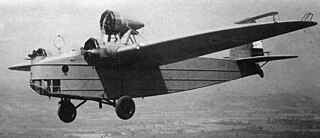
The Dornier Do Y was a trimotor German monoplane bomber of the early 1930s designed by Dornier Flugzeugwerke to an order by the Royal Yugoslav Air Force (RYAF). The Yugoslavs originally intended to use war reparations to pay for them, but ultimately had to use their own funds. Only a pair of aircraft were initially ordered to give the Yugoslavs experience with multi-engine bombers and Dornier failed to sell any more Do Y's. Two improved versions were subsequently built on speculation, but failed to find purchasers until the RYAF bought them in 1935.

The Sablatnig P.III was an airliner produced in Germany in the early 1920s.

The Scheibe SF-27 Zugvogel V is a single-seat Standard Class sailplane, designed and built in Germany in the 1960s. A motorised version was also produced. Significant numbers remain active.


